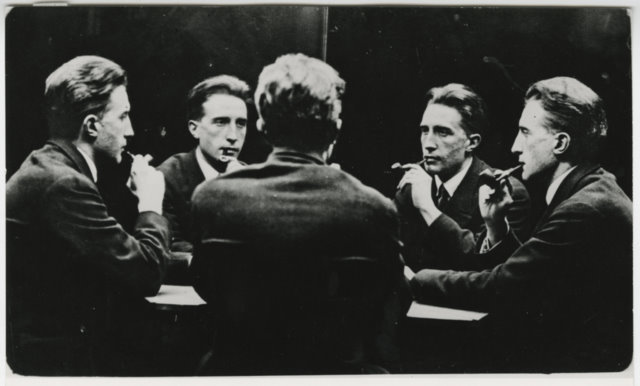
My Coffee with Duchamp
by Norman Dolph
There are two ways to get to know Marcel Duchamp:
- Live / Work / Visit Philadelphia and steep yourself in the museum that really ‘owns’ Duchamp. OR
- Be lucky enough to spend an afternoon with him in a coffee shop!
If you’re reading this, and fortunate enough to be in Philadelphia, you’ve seen and know the wonders of the Large Glass, Étant donnés, “Why Not Sneeze?”, Fountain, The Nude Descending the Staircase––the whole Duchamp panoply––you’ve used method #1.
Let me tell you about the afternoon of method #2.
It is 1961. Winter. I’m 22 at the time, working for Columbia Records in Chicago. I learned Duchamp was mounting a surrealist exhibition at the D’Arcy gallery in New York City. I was scheduled to visit NYC while this show was on.
My art history professor, George Heard Hamilton, was a good friend of Duchamp, and I asked the professor for the favor of a letter of introduction. He arranged for me to meet Duchamp on a Saturday afternoon. We met at the gallery and then adjourned to the Copper Kettle across the street at Madison Avenue and 82nd.
The ostensible purpose of the get-together was to discuss some recordings that Duchamp had made in the 1930’s, and what use might be made of them. But basically, I wanted to sit there and listen and ‘osmose’ and experience the vibrations of genius.
Such a quiet man. A twinkling man. A man who struck me as ‘easy with life’.
I came to the meeting with a lot of background knowledge from study. But it seemed important––not to impress him with the breadth and depth of my grok––but to just shut up and listen.
And he mused. He sipped. He laughed. He reflected. He conjectured. He spoke and sounded exactly like all the recordings you may have heard… or exactly as you imagine he would sound, if you only knew him from a photograph.
In short, he twinkled.
After an hour and a half or so, I had to leave to catch a plane back to Chicago–– leaving from the East Side Air Terminal on 38th street. He said, “I’m taking a cab home to east 18th street, I’ll drop you off on the way down”.
This led to the most memorable interchange I’ve ever had with another human being. We’re in the taxicab going down the FDR Drive. I have maybe ten minutes to 38th Street.
I KNOW––along with everyone else who follows Duchamp––that he gave up painting for chess, 20 or more years ago, improbable as that sounds.
I don’t think many people truly believed this, but Duchamp was as tight-lipped then, as Robert Mueller is now. I thought “Maybe he won’t suspect me?” He thinks I’m just a guy from Columbia Records interested in recorded ‘arcane-alia’. I’ll take a quiet, naïve sounding shot, leaving plenty of room for an answer that might reveal clues to Duchamp’s last two decades. (63rd Street, Queensboro Bridge, six minutes.)
I think––“Wait, don’t be stupid and embarrass this wonderful man/icon/genius, where he must create a response to some stupid question you might pose.” (49th Street, U.N. Garage, three minutes.)
“Self” I say, “Your heart is in the right place––take a shot”, so I ask…
“Are you working on anything lately?”
He pauses –– pauses a little more –– twinkles and says…
“You know, I used to paint because I thought I had something to say…
But then I realized….
I didn’t have to paint to say it.”
. . .
So next time you’re in Philadelphia, drop in and see what Duchamp was cooking up all the while. You are in such a lucky city with all those great works of art––pivot points on which the whole gyroscope of art steered a new direction. And when you stand in a gallery-full of Duchamp’s genius … mind-whisper to yourself in a lightly French-accented English:
“You know, I used to paint because I thought I had something to say…
But then I realized….
I didn’t have to paint to say it.”
Now you know Duchamp.
About Norman Dolph – Let’s see… Studied H.o.A & Engineering @ Yale. Long-time art collector, generally black-and-white – Baldessari, Ryman, Artschwager, Marden – that sort of thing. Produced The Velvet Underground & Nico for Warhol (“The Banana Album”).
In Philadelphia at the ICA, 1965, did the music for Warhol’s first major show. As a painter, did a Stations of the Cross series – exhibited at the 6th Biennale of Sacred Art at the Museo Stauros d’Arte – Teramo, Italy.
As a songwriter, “Life Is A Rock (But the Radio Rolled Me)” and Jane Olivor’s “Stay the Night.” Plus, cuts by Isaac Hayes, Patti LuPone, Eddie Kendricks, Bill Medley, Tracey Ullman. Other stuff too…
Long-time friend, patron and collector of the late Paul Laffoley.
Happily married! A variegated, enjoyable, optimistic, Vita Brevis.









